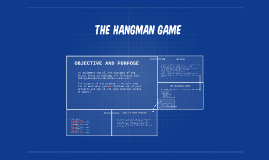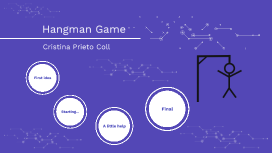Hangman Game
Transcript: Hangman Game: Python Chase Baker, Cristian Martinez, Jordyn Bibby Chase Baker, Cristian Martinez, Jordyn Bibby Introduction Intro What is the project? Our goals Why is it important What? What is our project? Hangman game through Python Our Goals Goals - We wanted to incorporate things we learned in class - (lists, loops, functions, boolean operations) - We wanted the game to be interactive and intuative for users, have a visual display of the hangman, allow players to track their guesses - We also wanted the game to have a random word function for single player games and an input function for two player Why we chose Hangman? Why? - We wanted to learn more about Python - Practice our programing skills - We wanted something that could be interactive with a user - This project also demostrates practical coding skills that we could use in a portfolio - We wanted something fun and nostalgic Methodology Methodology STEPS STEP 1 - WORDS Our first step was inputting words into our system and making sure its randomized. We imported the Natural Language Tool Kit and then wordnet, which is the English Dictionary. Wordnet works by grouping words together that are synonyms (synsets) and lemmas are the group of words in the synsets. We randomized both. STEP 2 - PEOPLE We had to create a function for 1 vs 2 player games. This was moreso a facial feature, as it made the game more intuitive. We added an or statement so that the game remained a 1 or 2 player game. 24-27 allowed us to use random words for 1 player and pick a word for two. STEP 3 - GUESSES We used a while true statement to create a never-ending loop. These codes show steps or responses to the user (what's in red). We used guess.isalpha function to make sure that letters are being guessed. 52-54 help us track the tries, 53 decreases the tries by 1, and 55-57 are used for once the player is out of tries STEP 4 - DISPLAY This is the function for the hangman display. The steps go by how many tries a player has left. STEP 5 - PLAY This is one of the most important features because it ties everything together. DEMO DEMO Hangman HANGMAN GAME https://colab.research.google.com/drive/1okGGeVHjVPcqpzZjXWcc2kYjvObHevlY#scrollTo=Yq2Y4okxSk4Z RESULTS RESULTS What were they? Results - Features FEATURES Results Results Overall the results were positive. We liked that the game hit all the points we wanted it to. They were also imformative becuase it helps us with trial and error a lot of times because sometimes the tries did not match the display, so it helped us fix that. Challenges Changes -Display Imaging/ play function - 1 and 2 Players Critical Evaluations Critical Eval - Time-management - User-experience - Versions Conclusion Conclusion This project was to improve our knowledge of Python, and to do this we created a hangman game. This game would have the capability to have 1 or 2 players, with the option to input your own word on the 2-player edition. It would also have coding using concepts we learned in class, while also making it efficient and learning new strategies. In the process of creating the game, we would run into issues like trouble-shooting to find specific issues, along with other technical issues. These allowed us to problem-solve and practice concepts to become more effective coders. This project is significant in many ways: we learned and practiced the technical side of coding in Python, while also learning real-life skills like management, interface design, and logical techniques. In the future, I think we would optimize the users' experience by creating themes and create more concise codes. Overall, the results of the project were what we envisioned and the actual process of creating the game was educational. USEFULNESS Usefulness -Concept Skills Loops, Boolean, String, etc. -Problem- Solving Debugging -User-interface -Management -Effective & Efficient Clear and Concise codes - Knowledge - Strategy - Results

















